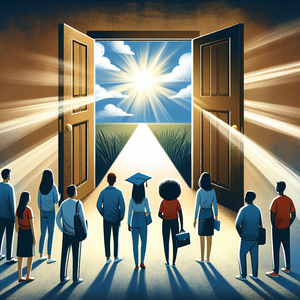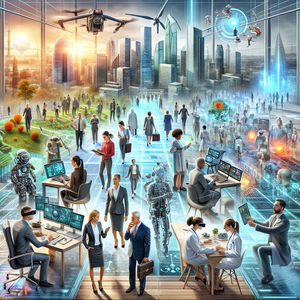The Aging Workforce Revolution: Redefining the Future of Work

The aging workforce is not merely a passing phenomenon—it is a demographic inevitability. Global populations are aging at an accelerated pace. According to the World Health Organization (WHO), by 2030, one in six people will be 60 or older, marking a significant increase in older demographics within the labor force. In countries like Japan, Italy, and Germany, where birth rates are low and populations are aging rapidly, older workers already form a critical segment of the workforce. Similarly, in the United States, the Bureau of Labor Statistics projects that workers aged 55 and older will make up nearly 25% of the labor force by 2030, making them the fastest-growing demographic in the American workforce. This shift is shaped by several factors. Advances in healthcare and medical technology have extended life expectancy and enabled people to remain physically and mentally active well into their later years. Financial considerations often compel older adults to continue working, as many face insufficient retirement savings or rising living costs. However, many older workers are motivated not by necessity but by desire—they find purpose, social connection, and intellectual stimulation in their jobs, choosing to stay employed for personal fulfillment. Together, these factors are driving a seismic shift in the workforce landscape, challenging traditional notions of retirement and career longevity.
Challenges of an Aging Workforce
While the aging workforce offers significant opportunities, it also presents challenges that organizations must tackle to create inclusive and productive workplaces. Even as the presence of older workers grows, many face age-related stereotypes. Common misconceptions paint older employees as resistant to change or less adept with technology, resulting in limited opportunities for advancement and, in some cases, outright discrimination. These biases can create barriers to employment and undermine the potential contributions of older workers. Though many older workers remain active and capable, age-related health concerns can arise. Businesses may need to introduce tailored workplace accommodations, such as flexible schedules, ergonomic office setups, and wellness programs, to support the physical and mental health of aging employees. As industries undergo rapid technological transformation, skill gaps can emerge, leaving older workers feeling outpaced. Without access to targeted training and reskilling initiatives, some may struggle to adapt to the demands of a digital-first economy.
The Opportunities of an Aging Workforce
Despite the challenges, the aging workforce offers tremendous advantages for organizations willing to embrace this demographic shift. Older employees bring unique qualities and experiences that can enhance workplace culture, innovation, and productivity. Older workers often possess decades of experience and deep industry-specific knowledge. This institutional memory can be invaluable for organizations as they navigate complex challenges. Mentorship programs that pair senior employees with younger staff can facilitate an intergenerational exchange of skills, ensuring that knowledge is retained and shared across the workforce. Research consistently shows that older workers excel in critical areas such as communication, conflict resolution, and leadership. These soft skills can enhance team dynamics, improve decision-making, and create a more harmonious workplace culture. Unlike younger generations, who are often more likely to switch jobs frequently, older workers tend to display greater loyalty and long-term commitment to their employers. This stability can reduce employee turnover costs while fostering a sense of continuity and reliability within organizations.
Innovative Strategies for Inclusion
Forward-thinking organizations are already taking proactive steps to harness the potential of the aging workforce. By implementing innovative policies and practices, companies are demonstrating that age-inclusive workplaces are not only possible but also highly beneficial. Companies like IBM and Deloitte have introduced flexible work options for older employees, including part-time roles, remote work, and adaptable schedules. These initiatives allow older workers to balance their professional responsibilities with their personal and health needs, keeping them engaged and productive. To address skill gaps, organizations such as AT&T and Accenture have launched targeted training programs designed to help older employees adapt to new technologies and remain competitive in an evolving job market. Lifelong learning initiatives can empower older workers to thrive in fast-changing industries. Some companies are fostering collaboration between generations by promoting age-diverse teams. For example, BMW redesigned its assembly lines to accommodate older workers by introducing ergonomic tools and encouraging cross-generational collaboration, resulting in increased productivity and innovation. Leading organizations like Procter & Gamble have initiated internal campaigns to challenge age-related stereotypes and promote a culture of inclusion. By actively addressing workplace biases, these companies are creating environments where employees of all ages can thrive.
Policy Implications and the Role of Governments
The aging workforce revolution extends beyond individual companies—it has significant implications for public policy and societal structures. Governments must address systemic challenges such as the sustainability of pension systems and the need for age-friendly labor policies. Raising the retirement age, offering tax incentives for businesses that hire older workers, and expanding access to lifelong learning programs are just a few strategies that can support older employees and ensure economic resilience. Public-private partnerships can also play a critical role in addressing the challenges of an aging workforce. By collaborating on initiatives such as reskilling programs, governments and businesses can create a more inclusive labor market that benefits workers of all ages.
The aging workforce revolution is not just a trend—it is a defining feature of the future of work. As businesses and societies grapple with talent shortages and shifting demographics, the contributions of older workers will become increasingly indispensable. By addressing challenges like ageism and skill gaps while investing in the strengths of older employees, organizations can unlock a powerful competitive advantage. An age-inclusive workplace benefits everyone. It fosters collaboration, innovation, and resilience while creating opportunities for intergenerational learning and growth. As the workforce continues to evolve, the question is no longer whether older workers have a place in the modern economy—it is how we can create systems, cultures, and policies that empower them to thrive. The revolution is already underway. Will your organization rise to the challenge and embrace the future of work?
Workforce Diversity and Inclusion Specialist
Procter & Gamble, Deloitte, public sector organizations
Responsibilities
Develop and implement strategies to promote age diversity and inclusivity in the workplace, addressing issues like ageism and bias.
Design training programs to educate employees on the value of intergenerational collaboration.
Collaborate with HR and leadership teams to create policies that support older employees, such as flexible work arrangements or mentorship opportunities.
Corporate Wellness Program Manager
IBM, hospitals, wellness-focused organizations
Responsibilities
Create and manage health and wellness initiatives tailored to aging employees, including ergonomic workplace designs and mental health support.
Conduct assessments to identify unique health needs among older workers and recommend targeted interventions.
Partner with benefits providers to ensure access to comprehensive healthcare options and preventative care programs.
Unique Skills
Expertise in gerontology or workplace ergonomics is often valued.
Upskilling and Reskilling Program Manager
AT&T, Accenture, government workforce development agencies
Responsibilities
Develop and oversee training programs to help older employees adapt to evolving technologies and industry standards.
Partner with educational institutions or tech providers to deliver accessible, lifelong learning opportunities.
Track employee progress and measure the impact of training on productivity and engagement.
Ergonomics Specialist
BMW, healthcare organizations, consulting firms specializing in workplace safety
Responsibilities
Assess workplace environments to identify areas where physical accommodations can improve productivity and comfort for older employees.
Recommend and implement solutions such as standing desks, adjustable seating, or optimized workflows on factory floors.
Collaborate with HR and facilities teams to ensure compliance with health and safety standards.
Unique Skills
Background in occupational health or industrial design.
Intergenerational Workforce Consultant
McKinsey, regional workforce development programs, freelance consultancy roles
Responsibilities
Advise businesses on strategies to foster collaboration and knowledge sharing between younger and older employees.
Design mentorship and reverse-mentorship programs to leverage the expertise of older workers while integrating fresh perspectives from younger staff.
Conduct workshops and team-building exercises to address generational differences and improve communication.


